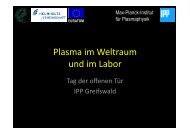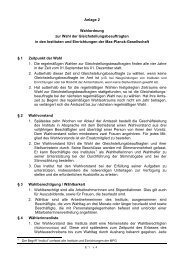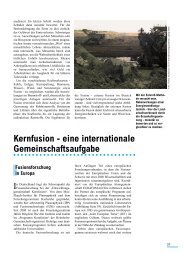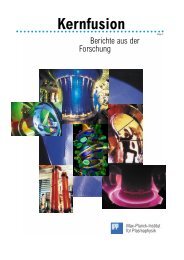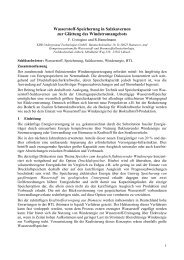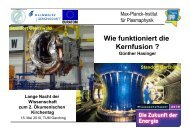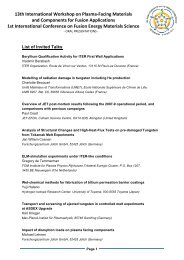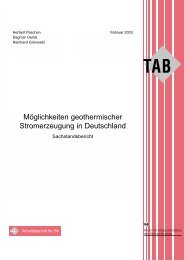IPP Annual Report 2007 - Max-Planck-Institut für Plasmaphysik ...
IPP Annual Report 2007 - Max-Planck-Institut für Plasmaphysik ...
IPP Annual Report 2007 - Max-Planck-Institut für Plasmaphysik ...
You also want an ePaper? Increase the reach of your titles
YUMPU automatically turns print PDFs into web optimized ePapers that Google loves.
led to the establishment of the department ”Configuration<br />
Control” whose tasks became to ensure collision-free operation<br />
at all times. These two new departments were combined<br />
with the department ”Design Office” under the umbrella of<br />
one subdivision in order to simplify fast and effective collaboration<br />
between departments that naturally interact<br />
strongly with one another. After about a half year of operation<br />
this organisation has shown its effectiveness in supporting<br />
the device assembly on all aspects by implementing well<br />
defined fast and transparent work flows with a clear distribution<br />
of responsibilities and comprehensive and up-to-date<br />
documentation.<br />
5.1 Configuration Management<br />
The department Configuration Management (DC-CM) plans,<br />
implements and leads the processes that are required to<br />
ensure permanent consistency between the requirements of<br />
the W7-X system specification and the performance attributes<br />
of its components throughout the life time of the<br />
project. The detailed tasks of DC-CM are oriented at the<br />
common standards of configuration management (CM).<br />
CM for W7-X is being implemented with most efficient use<br />
and interlink of existing processes (change request, nonconformances,<br />
interface control, collision control) and tools<br />
(KKS project structure, the PLM-system, data bases).<br />
5.1.1 Change Management<br />
Change Management (CM) controls all change processes,<br />
preserves configuration control at the interfaces, ensures<br />
documentation and consistent implementation in the configuration<br />
of all changes and variances, and provides orderly<br />
communication of change information within the project.<br />
This includes that CM enables change and non-conformance<br />
decisions to be based on the knowledge of complete<br />
change impact. Processes are controlled via a data base.<br />
Highest priority is given to fast handling of change and<br />
non-conformance processes which are time-critical and<br />
might affect the schedule of device assembly. These are<br />
actively guided and driven by CM and thus accelerated.<br />
CM supports preparation and documentation of the configuration<br />
control board (CCB) meetings and the implementation<br />
of its decisions.<br />
5.1.2 Configuration Status Accounting<br />
A PLM-based concept for the W7-X system documentation<br />
has been implemented. It will give access to the complete<br />
configuration information and finally replace the previous<br />
system specification. A central master document for each<br />
W7-X component, the so called loose leaf book, provides<br />
the description of the function of a component and its positioning<br />
in the project structure and the CAD assembly.<br />
Additionally, the loose leaf book is a navigation tool (via<br />
references in the document and links in the PLM system)<br />
Wendelstein 7-X<br />
45<br />
to access specifications, data sheets, interface descriptions,<br />
design changes, and variances that result from non-conformances.<br />
Provision of interface descriptions and accounting<br />
for change impacts across the interfaces is coordinated by<br />
CM. Masses, materials and their composition are documented<br />
for all components within the torus hall in a material<br />
data base. Additionally, the data base documents the certified<br />
relative magnetic permeability of the materials used and<br />
their certified cobalt content as a basis for assessment of<br />
magnetic field errors and to keep track of the amount of<br />
cobalt, which is limited by the authorities due to its high<br />
neutron activation rate.<br />
5.2 Configuration Control<br />
The main missions of the department Configuration<br />
Control (CC) are to ensure collision-free operation of W7-X<br />
for all modes of operation and to coordinate the space<br />
requests of peripheral components in the torus hall and<br />
adjacent buildings. This is being accomplished by developing<br />
the required tools for generating and book-keeping of<br />
the CAD models of the relevant components by performing<br />
the collision checks and finally by initiating and leading the<br />
processes required to eliminate detected conflicts in collaboration<br />
with CM. W7-X is undoubtedly a device with<br />
high geometrical complexity. Especially in the cryostat one<br />
has to deal with three-dimensional free-form shapes of the<br />
coils snugly located between the heat shields of the thermal<br />
insulation of the plasma vessel and the ports, the coil support<br />
structure the meandering lines of the bus-bars and the cryogenic<br />
helium supply, the diagnostic and quench detection<br />
cables and all the required supports and additional components.<br />
Figure 19 illustrates this situation in the cryostat.<br />
Figure 19: Module 5 of the cryostat (outer vessel shell omitted)




